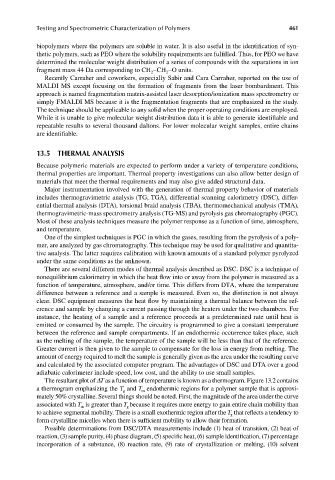Page 498 - Carrahers_Polymer_Chemistry,_Eighth_Edition
P. 498
Testing and Spectrometric Characterization of Polymers 461
biopolymers where the polymers are soluble in water. It is also useful in the identification of syn-
thetic polymers, such as PEO where the solubility requirements are fulfilled. Thus, for PEO we have
determined the molecular weight distribution of a series of compounds with the separations in ion
fragment mass 44 Da corresponding to CH –CH –O units.
2 2
Recently Carraher and coworkers, especially Sabir and Cara Carraher, reported on the use of
MALDI MS except focusing on the formation of fragments from the laser bombardment. This
approach is named fragmentation matrix-assisted laser desorption/ionization mass spectrometry or
simply FMALDI MS because it is the fragmentation fragments that are emphasized in the study.
The technique should be applicable to any solid when the proper operating conditions are employed.
While it is unable to give molecular weight distribution data it is able to generate identifi able and
repeatable results to several thousand daltons. For lower molecular weight samples, entire chains
are identifi able.
13.5 THERMAL ANALYSIS
Because polymeric materials are expected to perform under a variety of temperature conditions,
thermal properties are important. Thermal property investigations can also allow better design of
materials that meet the thermal requirements and may also give added structural data.
Major instrumentation involved with the generation of thermal property behavior of materials
includes thermogravimetric analysis (TG, TGA), differential scanning calorimetry (DSC), differ-
ential thermal analysis (DTA), torsional braid analysis (TBA), thermomechanical analysis (TMA),
thermogravimetric-mass spectrometry analysis (TG-MS) and pyrolysis gas chromatography (PGC).
Most of these analysis techniques measure the polymer response as a function of time, atmosphere,
and temperature.
One of the simplest techniques is PGC in which the gases, resulting from the pyrolysis of a poly-
mer, are analyzed by gas chromatography. This technique may be used for qualitative and quantita-
tive analysis. The latter requires calibration with known amounts of a standard polymer pyrolyzed
under the same conditions as the unknown.
There are several different modes of thermal analysis described as DSC. DSC is a technique of
nonequilibrium calorimetry in which the heat flow into or away from the polymer is measured as a
function of temperature, atmosphere, and/or time. This differs from DTA, where the temperature
difference between a reference and a sample is measured. Even so, the distinction is not always
clear. DSC equipment measures the heat flow by maintaining a thermal balance between the ref-
erence and sample by changing a current passing through the heaters under the two chambers. For
instance, the heating of a sample and a reference proceeds at a predetermined rate until heat is
emitted or consumed by the sample. The circuitry is programmed to give a constant temperature
between the reference and sample compartments. If an endothermic occurrence takes place, such
as the melting of the sample, the temperature of the sample will be less than that of the reference.
Greater current is then given to the sample to compensate for the loss in energy from melting. The
amount of energy required to melt the sample is generally given as the area under the resulting curve
and calculated by the associated computer program. The advantages of DSC and DTA over a good
adiabatic calorimeter include speed, low cost, and the ability to use small samples.
The resultant plot of ΔT as a function of temperature is known as a thermogram. Figure 13.2 contains
a thermogram emphasizing the T and T endothermic regions for a polymer sample that is approxi-
g m
mately 50% crystalline. Several things should be noted. First, the magnitude of the area under the curve
associated with T is greater than T because it requires more energy to gain entire chain mobility than
m g
to achieve segmental mobility. There is a small exothermic region after the T that reflects a tendency to
g
form crystalline micelles when there is sufficient mobility to allow their formation.
Possible determinations from DSC/DTA measurements include (1) heat of transition, (2) heat of
reaction, (3) sample purity, (4) phase diagram, (5) specific heat, (6) sample identification, (7) percentage
incorporation of a substance, (8) reaction rate, (9) rate of crystallization or melting, (10) solvent
9/14/2010 3:42:15 PM
K10478.indb 461 9/14/2010 3:42:15 PM
K10478.indb 461

